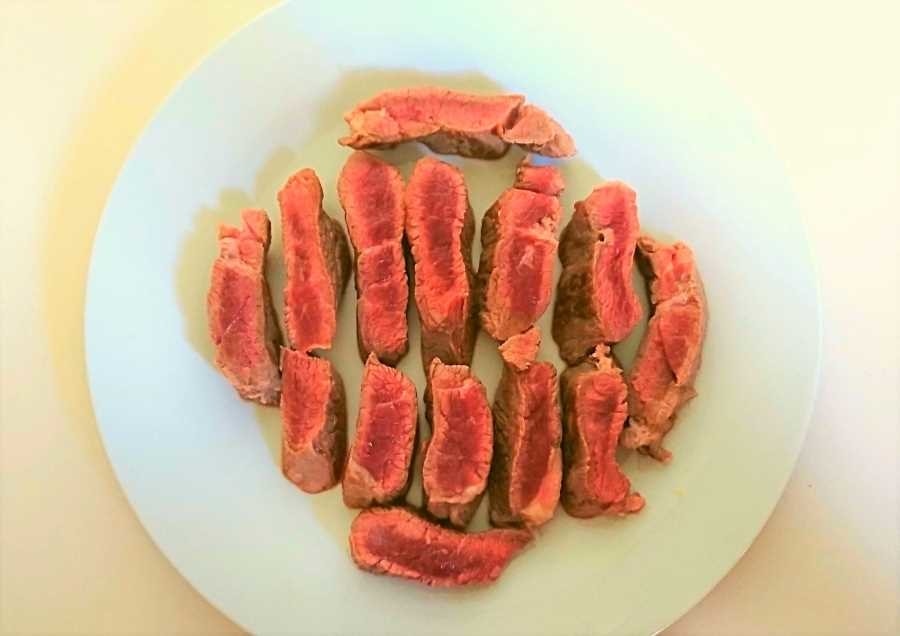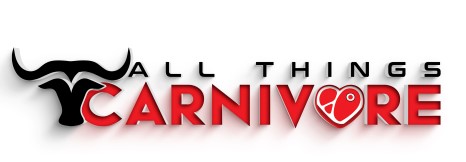Steak, especially beef steak, is the staple of the carnivore diet and you should definitely learn how to cook a perfect steak if you decide to follow this diet. In this post, I will show you how to cook a perfect steak every time in a few simple steps.
As I have mentioned many times on this site, ruminant meat should be your go-to meat on the carnivore diet.
For millions of years, our ancestors dined on large herbivores and drove them to extinction.[1] The closest you can get to large herbivores these days are ruminants like bison, cows, elks, and buffaloes.
Furthermore, they are amongst the best-raised farmed animals these days. Please read this post where I discuss in detail how cows, pigs, chickens, and fish are farmed these days.
In summary, farmed ruminants still spend most of their lives outdoor and eat a diet relatively close to their natural diets. They typically spend a large part of their lives grazing before finishing on grains. Pigs and chickens, however, generally spend their entire lives in crowded sheds or cages and are fed a composite diet that is very different from their natural diets.
If you can afford and get access to ruminant meat, especially pasture-raised meat, please make it the core of your diet and do eat a lot of steaks.
How to cook the perfect beef steak on the carnivore diet
1- Bring the steak to room temperature
Take the steak out of the fridge for at least 30 minutes before you plan to cook it. This is for about 2 cm thick steaks. If you use a thicker one (e.g. 4cm to 6cm steak), take it out for at least 1 hour before cooking.
I usually just use a pinch of salt for each side. If you like to use seasonings such as salt, pepper, or herbs, rub them on both sides of the steak now and then leave it on the kitchen bench.
The reason for bringing the steak to room temperature is if you want to have a blue, rare, or medium-rare steak, the cooking time is very short and if you don’t bring the steak to room temperature, you may end up with a steak that is still cold in the middle and cooked unevenly.
2- Cook the steak
Heat the frying pan until very hot but not burning. This will help caramelize the meat and deliver a nice crust. Test the pan with a few drops of water, if the water sizzle and evaporate quickly, it’s hot enough.
Add a tablespoon of animal fat, wait for a moment then add the steak. Note, if you don’t like charred flavors or dark crust, bring the heat down to medium after adding the steak.
For a 2cm-thick steak and rare doneness, let it cook for 1½ minutes before turning over and cook the other side for 1½ more minutes. Resist the temptation to turn the steak frequently.
Pick up the steak with thongs and brown the edges of the steak too. Rest the steak for 2 minutes before serving.
I like blue to rare doneness the most and this has been how I cook steaks long before carnivore.
If you like different levels of doneness, the cooking time will vary as follows:[2, 3]
- Blue: cook for 1 minute each side, rest for 10 minutes. Blue steak requires a longer resting time. Before serving, return to a hot frying pan for 15 seconds each side. The steak is basically just seared and the inside of the steak is completely red and raw. This would suit those of you who want to eat raw meat but can’t find a reliable source and want to stay on the safe side
- Rare: cook for 1½ minutes for each side, rest for 2 minutes. A rare steak is cooked on the outside only leaving about 70% red. It is soft, juicy and flavorsome
- Medium rare: cook for 2 minutes each side, rest for 4 minutes. A medium rare steak is many people’s favourite, with about 50% cooked greyish, leaving 50% redness inside
- Medium: cook for 2¼ minutes each side, rest for 4 minutes. The steak is almost cooked through leaving only a hint of pink in the middle. At about 120F to 140F, some proteins begin to denature releasing juice and as result, a medium steak is likely to be a bit chewy and dry
- Well-done: cook for 4-5 minutes each side, rest for 6 minutes. This steak is cooked through and likely to be dry, chewy and void of flavor. Whatever you do, please don’t go for well done, it’ll be a waste of a good piece of meat.
From blue to well-done, which one is the best?
This is a personal decision, but in my view, blue, rare to medium-rare are better choices. Not only do they taste better but are likely to retain more nutrients and support digestion.
As I wrote in this post, on the carnivore diet, it’s good to eat a mixture of cooked, lightly cooked, and raw if tolerated. The main reason for this is cooking can increase bioavailability in some foods while destroying nutrients and hindering digestion in other foods.
Muscle meat has a small amount of vitamin C (organ meat has a bit more) which will be destroyed by heat, so it’s best to cook your steak blue, rare, or medium-rare to preserve the vitamin C content. Please read this post for a more detailed discussion about vitamin C on the carnivore diet.
Some people on the carnivore diet swear that they feel much better on raw meat than cooked meat.
This may be due to the fact that cooking denatures some proteins at high temperatures as well as destroys natural enzymes in meat which help our body digest it better.
Alexander Ugolev, a famous Russian scientist once conducted a well-known experiment with two dead frogs, one cooked and one uncooked. He placed each into a cup filled with a carnivore’s stomach acid. The uncooked frog was completely dissolved while the cooked frog remained largely intact with only minor surface change.
Based on this experiment alone, raw meat is definitely better for digestion than cooked meat. This is how carnivores in the wild eat, they don’t cook or season their prey.
Biologically, we are mostly carnivores, our stomach acid is even higher than in carnivores, equaling that of scavengers indicating a meat diet in which the acid would provide protection from harmful bacteria.[3]
However, a major problem with eating raw meat today is the risk of contamination. Most of us would just get meat from the butchers or the supermarkets and we don’t know how safely they have been processed.
So unless you’re able to get your meat from reliable sources, searing the meat well on the outside while leaving the inside uncooked will give you the best of both. Also, use thicker cuts so proportionally you will eat more raw than cooked meat.
However, when you first start the carnivore diet, cook the meat the way you like it, rare, medium, or well-done. The focus at this stage is to get yourself familiarized with this diet. Later on, when you are on a mostly carnivore diet, experiment with different types of doneness to see how you feel.
Tips
Overnight marinate to enhance flavor
If you can tolerate herbs and spices on the carnivore diet, season the steak the way you like it the night before and keep it in the fridge overnight. The thicker the steak, the more seasonings you should use. Take the steak out the next morning and bring it to room temperature before cooking. This will greatly enhance the flavor of the steak.
If you have some health issues and would like to see if they can be resolved with the carnivore diet, please stay away from herbs and spices and all kinds of seasonings until you figure out exactly what food causes you the problems.
Use a heavy cast iron pan for even heat
A large heavy thick-based frying pan is best for cooking steak because it can get very hot and help produce that crusty finish. It is also good at allowing heat to distribute evenly.
Though you can also cook a steak in the oven, I prefer to use an ordinary frying pan or a griddle pan, it’s quick and easy and less cleaning. Good quality meat itself has a lot of flavors. The aim of cooking a steak for me is to render it safe with quick searing of the outer layer while retaining the flavors and nutrients inside the steak.
Don’t skip resting
Give the steak a good rest as per the timing guide above. The steak will continue to cook after it’s removed from the frying pan. This will also allow it to reabsorb its juice, giving you a more tender, tasty, and juicy steak. If you cut it straight away, all the juice will be draining out of the steak and goes to waste.
Don’t reheat leftover steak in microwave
If you happen to have leftover steak, please don’t reheat it in the microwave, it will cook through the steak quickly leaving you with a dry and rubbery piece of meat.
Take it out of the fridge about 30 minutes before you want to eat it. Heat up a frying pan, add a bit of fat or butter and give it a quick sear on both sides.
Choosing the best cuts
To me, the best cuts of beef for steaks are ones that have both fat and lean meat that are tender.
So, rib-eye steak (aka scotch fillet or rib fillet) is probably the best. It is juicy, tasty, tender, and full of flavor. If you can afford this, this is the best to eat on the carnivore diet.
Fillet steak (aka eye fillet or tenderloin) which comes from the muscles near the backbone is very lean and tender and probably the most desirable steak. However, if you like fillet steak, use generous fat when cooking to get more fat in your diet and enhance the flavor of the steak.
Sirloin steak (aka porterhouse steak or New York steak) comes from the back of the animal between the fore-rib and the rump. This cut is also lean, tender, juicy, and rich in flavor. This cut is, however, too lean for me. If you like it, consider adding fat generously when cooking or adding some butter towards the end of the cooking process.
Rump steak comes from the backside of the animal which requires more work and, as a result, is not as tender as a fillet or sirloin. It is a cheaper cut but actually has the best beef flavor.
T-bone steak is a cut from the short loin with a T-shape bone. It has combined textures and flavors of a New York steak and a fillet steak. T-bone steak is one of the most prized cuts of beef.
Flat iron steak (aka feather blade steak or oyster blade steak) is a cut from the chuck or shoulder of the animal. It is relatively tender and well-marbled and has a lot of hearty beef flavor. It is a great budget cut that doesn’t compromise flavor.
Some cuts are popular or expensive because they are more tender with better flavor and make up a smaller portion of the animal. However, that does not mean that they are nutritionally better. The best cut is probably the one that you enjoy and can afford.

Please check out my other carnivore diet recipes here and the carnivore diet library here which are updated regularly.
Disclaimer: The information in this post is for reference purposes only and not intended to constitute or replace professional medical advice. Please consult a qualified medical professional before making any changes to your diet or lifestyle.





